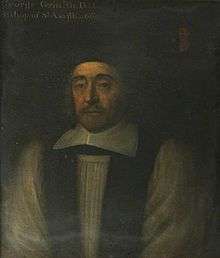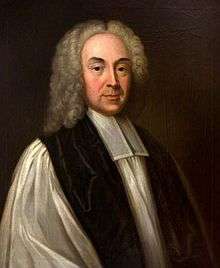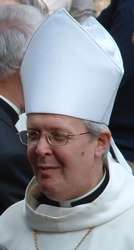Bishop of St Asaph
| Bishop of St Asaph | |
|---|---|
| Bishopric | |
| anglican | |
 | |
|
Incumbent: Gregory Cameron | |
| Province | Wales |
| Diocese | St Asaph |
| Cathedral | St Asaph Cathedral |
The Bishop of St Asaph heads the Church in Wales diocese of St Asaph.
The diocese covers the counties of Conwy and Flintshire, Wrexham county borough, the eastern part of Merioneth in Gwynedd and part of northern Powys. The Episcopal seat is located in the Cathedral Church of St Asaph in the city of St Asaph in Denbighshire, north Wales.
The Bishop's residence is Esgobty, St Asaph. The current bishop is Gregory Cameron, who was elected on 5 January and consecrated on 4 April 2009. He became Bishop of St Asaph in succession to John Davies, who was consecrated in October 1999 and who retired in 2008.[1]
Early times
This diocese was supposedly founded by St Kentigern (Cyndeyrn) about the middle of the 6th century, although this is unlikely. The date often given is 583. Exiled from his see in Scotland, Kentigern is said to have founded a monastery called Llanelwy – which is the Welsh name for St Asaph – at the confluence of the rivers Clwyd and Elwy in north Wales, where after his return to Scotland he was succeeded by Asaph or Asa, who was consecrated Bishop of Llanelwy. The Diocese of Llanelwy originally largely coincided with the kingdom of Powys, together with the part of the kingdom of Gwynedd known as Gwynedd Is Conwy, but lost much territory first by the Mercian encroachment marked by Watt's dyke and again by the construction of Offa's Dyke, soon after 798. Nothing is known of the history of the diocese during the disturbed period that followed. Some historians doubt the existence of the diocese per se before the Norman period, and the bishop list and the fact that the Diocese of Bangor, in the kingdom of Gwynedd, held large tracts of land there tends to confirm this.
Middle Ages
Domesday Book gives scanty particulars of a few churches but is silent as to the cathedral. Early in the twelfth century Norman influence asserted itself and in 1143 Theobald, Archbishop of Canterbury, consecrated one Gilbert as Bishop of St. Asaph, but the position of his successors was very difficult and one of them, Godfrey, was driven away by poverty and the hostility of the Welsh. A return made in the middle of the thirteenth century (London, British Library, Cotton Vitellius, c. x.) shows the existence of eight rural deaneries, seventy-nine churches, and nineteen chapels. By 1291 the deaneries had been doubled in number and there were Cistercian houses at Basingwerk, Aberconwy, Strata Marcella and Valle Crucis, and a Cistercian nunnery, Llanllugan Abbey. The cathedral, which had been burnt in the wars, was rebuilt and completed in 1295. Dedicated to St Asaph, it was a plain massive structure of simple plan, and was again destroyed during the Wars of the Roses. When it was restored by Bishop Redman the palace was not rebuilt and thus the bishops continued to be nonresident, notwithstanding the fact that in the late Middle Ages the bishop had five episcopal residences, four of which were alienated under Edward VI of England. At the end of the fifteenth century there was a great revival of church building, as is evidenced by the churches of that date still existing in the diocese. The chief shrines in the diocese were St Winefred's Well, St Garmon in Yale, St Derfel Gadarn in Edeirnion, St Melangell at Pennant, and the Holy Cross in Strata Marcella. All these were demolished at the Reformation. At that time the diocese contained one archdeaconry, sixteen deaneries, and one hundred and twenty-one parishes.
The names and succession of the bishops after Saints Kentigern and Asaph are not clearly known until 1143. The last bishop in communion with Rome was Thomas Goldwell, who acceded in 1555 and was in the process of being transferred to Oxford when Queen Mary died and Elizabeth I came to the throne. Goldwell fled to the Continent and died in Rome on 13 April 1585, the last surviving member of the pre-Reformation hierarchy. The see continued to be part of the Church of England until the Church was disestablished in Wales in 1920, since when it has been part of the (Anglican) Church in Wales.
List of the Bishops of St Asaph
Pre-reformation bishops
| Bishops of St Asaph | |||
|---|---|---|---|
| From | Until | Incumbent | Notes |
| 6th century AD | Kentigern (Saint Mungo) | Originally Bishop of Glasgow from c. 540; founded diocese as episcopus Elvensis, Elguensis, Elveiisis, Lanelwensis | |
| 6th century AD | Saint Asaph | ||
| c. 600 | Tysilio | ||
| c. 800 | Renchidus | ||
| c. 928 | Cebur | ||
| c. 1070 | Melanus | ||
| 1143 | c. 1151 | Gilbert | See recreated as suffragan of Canterbury |
| c. 1152 | 1154 | Geoffrey of Monmouth | |
| 1154 | 1155 | Richard | Died in office |
| c. 1160 | 1165 | Godfrey | Left see to become abbot of Abingdon in 1165, removed from office in 1175 |
| 1175 | 1181 | Adam the Welshman | Canon of Pershore |
| 1183 | c. 1186 | John I | |
| 1186 | c. 1224 | Reiner | |
| 1225 | c. 1233 | Abraham | |
| 1235 | c. 1241 | Hugh | Monk of the Friars |
| 1242 | 1247 | Hywel ab Ednyfed | Also known as Howel ap Ednevet |
| 1247 | 1249 | vacant | |
| 1249 | 1266 | Einion I | Also known as Anian |
| 1267 | 1268 | John II | |
| 1268 | 1293 | Einion II | Also known as Anian de Schonau, prior of Rhudland |
| 1293 | 1314 | Llywelyn de Bromfield | Also known as Leolinus de Bromfield |
| 1315 | c. 1352 | Dafydd ap Bleddyn | Also known as David ap Blethin; canon of St. Asaph |
| 1352 | 1357 | John Trevor (I) | Also known as John Trevaur |
| 1357 | 1375 | Llywelyn ap Madog | Also known as Leolinus ap Madoc ap Elis; dean of St. Asaph |
| 1376 | 1382 | William Spridlington | Also known as William de Spridlington; dean of St. Asaph |
| 1382 | 1389 | Lawrence Child | Monk of Battle Abbey, licentiate of the civil law |
| 1390 | 1394 | Alexander Bache | Also known as Alexander Bach; canon of St. Asaph |
| 1395 | 1402 | John Trevor (II) | Prebendary of Hereford; deprived, possibly reinstated following David II as see not declared vacant prior to his death in 1410 |
| 1402 | c. 1408 | David II | |
| 1411 | c. 1433 | Robert Lancaster | Also known as Robert of Lancaster |
| 1433 | 1444 | John Low | Also known as John Lobbe; a friar eremite; translated to Rochester |
| 1444 | 1449 | Reginald Pecock | Also known as Reginald Peacock; translated to Chichester |
| 1450 | 1463 | Thomas Bird | Also known as Thomas Knight; deprived for rebellion; temporalities of the diocese to the king, the bishop of Rochester, Robert Caunton, and John Stanley before the pardoning of Thomas in 1471 |
| 1471 | 1495 | Richard Redman | Translated to Exeter |
| c. 1495 | 1500 | Michael Deacon | Also known as Michael Dyacon; the king's confessor |
| 1500 | 1503 | Dafydd ab Ieuan ab Iorwerth | Also known as David ap Yeworth; abbot of Valle Crucis |
| c. 1503 | c. 1513 | Dafydd ab Owain | Also known as David ap Owen; Abbot of Valle Crucis (Aberconwy?) |
| 1513 | 1518 | Edmund Birkhead | Also known as Edmund Brokehed |
| 1518 | 1535 | Henry Standish | |
During the Reformation
| Bishops of St Asaph | |||
|---|---|---|---|
| From | Until | Incumbent | Notes |
| c. 1535 | 1536 | William Barlow | Translated to St David's, then Bath & Wells, then Chichester |
| 1536 | 1554 | Robert Parfew | Also known as Robert Warton; abbot of St. Savior's Bermondsey; translated to Hereford |
| 1556 | c. 1559 | Thomas Goldwell CR | Went into voluntary exile |
Post-Reformation
Bishops of the Church of England
| Bishops of St Asaph | |||
|---|---|---|---|
| From | Until | Incumbent | Notes |
| 1560 | 1561 | Translated to St David's | |
| 1561 | 1573 | ||
| 1573 | 1600 | ||
| 1601 | 1604 |  William Morgan William Morgan |
Translator of the Bible into Welsh. Translated from Llandaff |
| 1604 | 1623 | Dean of Bangor | |
| 1624 | 1629 | Prebendary of Worcester | |
| 1629 | 1651 | Archdeacon of St Asaph; died in office | |
| 1651 | 1660 | vacant | For 9 years |
| 1660 | 1666 |  George Griffith George Griffith |
Archdeacon of St Asaph |
| 1667 | 1670 | Dean of Bristol | |
| 1670 | 1680 | Translated from Sodor & Man | |
| 1680 | 1692 |  William Lloyd William Lloyd |
Dean of Bangor; translated to Lichfield & Coventry, then Worcester |
| 1692 | 1703 | Translated from Cloyne, Ireland | |
| 1703 | 1704 |  George Hooper George Hooper |
Dean of Canterbury; translated to Bath & Wells |
| 1704 | 1708 |  William Beveridge William Beveridge |
Archdeacon of Colchester |
| 1708 | 1714 |  William Fleetwood William Fleetwood |
Canon of Windsor; translated to Ely |
| 1714 | 1727 |  John Wynne John Wynne |
Principal of Jesus College, Oxford; translated to Bath & Wells |
| 1727 | 1731 | Dean of Worcester and of St Paul's in London; translated to Chichester | |
| 1732 | 1735 |  Thomas Tanner Thomas Tanner |
Canon of Christ Church, Oxford |
| 1736 | 1743 | Dean of Wells; translated to Worcester | |
| 1743 | 1744 | Dean of Peterborough; elected in Nov. but translated to Lincoln in Jan. before consecration | |
| 1744 | 1748 |  Samuel Lisle Samuel Lisle |
Archdeacon of Canterbury; translated to Norwich |
| 1748 | 1761 |  Robert Hay Drummond Robert Hay Drummond |
Prebendary of Westminster; translated to Salisbury |
| 1761 | 1769 |  Richard Newcome Richard Newcome |
Translated from Llandaff |
| 1769 | 1788 |  Jonathan Shipley Jonathan Shipley |
Translated from Llandaff |
| 1789 | 1790 |  Samuel Hallifax Samuel Hallifax |
Also known as Samuel Halifax; translated from Gloucester |
| 1790 | 1802 |  Lewis Bagot Lewis Bagot |
Translated from Norwich |
| 1802 | 1806 |  Samuel Horsley Samuel Horsley |
Translated from Rochester |
| 1806 | 1815 |  William Cleaver William Cleaver |
Translated from Bangor |
| 1815 | 1830 | Translated from Hereford | |
| 1830 | 1846 |  William Carey William Carey |
Translated from Exeter |
| 1846 | 1870 |  Thomas Vowler Short Thomas Vowler Short |
Translated from Sodor & Man |
| 1870 | 1889 |  Joshua Hughes Joshua Hughes |
Vicar of Llandovery |
| 1889 | 1920 |  Alfred George Edwards Alfred George Edwards |
Church in Wales disestablished 1920 |
Bishops of the disestablished Church in Wales
| Bishops of St Asaph | |||
|---|---|---|---|
| From | Until | Incumbent | Notes |
| 1920 | 1934 |  Alfred George Edwards Alfred George Edwards |
First Archbishop of Wales 1920–1934 |
| 1934 | 1950 | ||
| 1950 | 1971 | ||
| 1971 | 1982 | ||
| 1982 | 1999 | Archbishop of Wales 1991–1999 | |
| 1999 | 2008 | ||
| 2009 | incumbent |  Gregory Cameron Gregory Cameron |
Consecrated 4 April 2009 |
| Source(s):[2][3] | |||
Notes
- ↑ "New Bishop of St Asaph is chosen". BBC. 2009-01-05. Retrieved 2009-01-05.
- ↑ Hardy, T. Duffus. Fasti Ecclesiae Anglicanae; or, a Calendar of the Principal Ecclesiastical Dignitaries in England and Wales, and of the Chief Officers in the Universities of Oxford and Cambridge from the Earliest Times to the Year MDCCXV, Corrected and Continued to the Present Time, Vol. I, "St. Asaph's". Oxford Univ. Press, 1854. Accessed 18 Feb 2013.
- ↑ "Historical successions: St Asaph". Crockford's Clerical Directory. Retrieved 22 July 2012.
References
- Haydn's Book of Dignities (1894) Joseph Haydn/Horace Ockerby, reprinted 1969
- Whitaker's Almanack 1883 to 2004 Joseph Whitaker & Sons Ltd/A&C Black, London
- https://web.archive.org/web/20050320015243/http://tejones.net/religion/Bishops/
![]() This article incorporates text from a publication now in the public domain: Herbermann, Charles, ed. (1913). "Ancient Diocese of Saint Asaph". Catholic Encyclopedia. New York: Robert Appleton.
This article incorporates text from a publication now in the public domain: Herbermann, Charles, ed. (1913). "Ancient Diocese of Saint Asaph". Catholic Encyclopedia. New York: Robert Appleton.